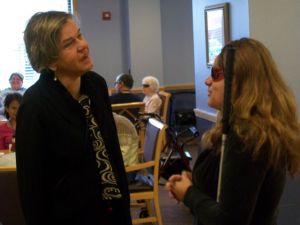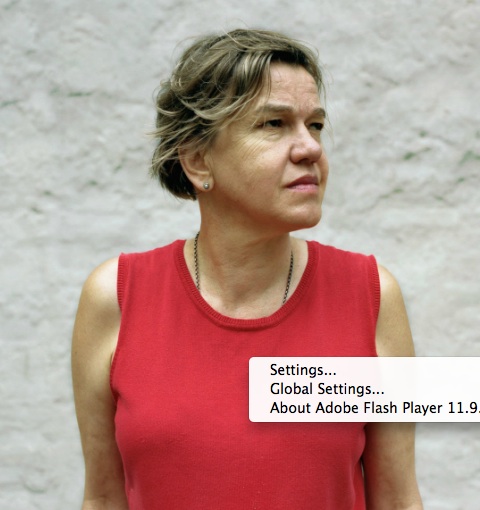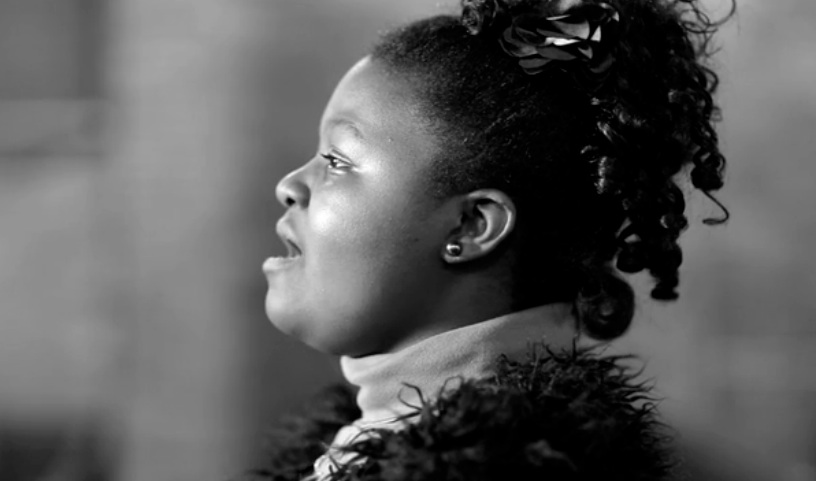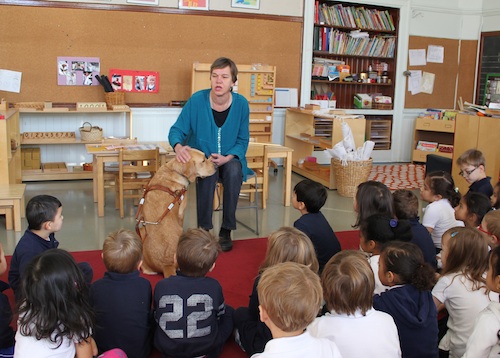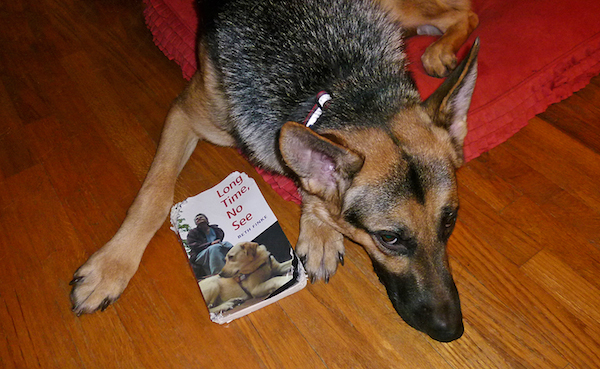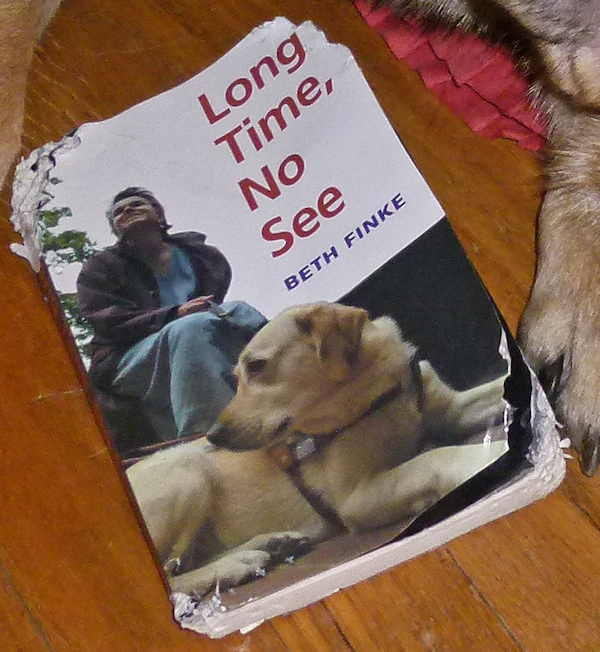Go ahead and brag
November 9, 2013 • 10 Comments • Posted in blindness, book tour, Braille, parenting a child with special needs, public speaking, technology for people who are blind, travel, Uncategorized, visiting schools, Writing for Children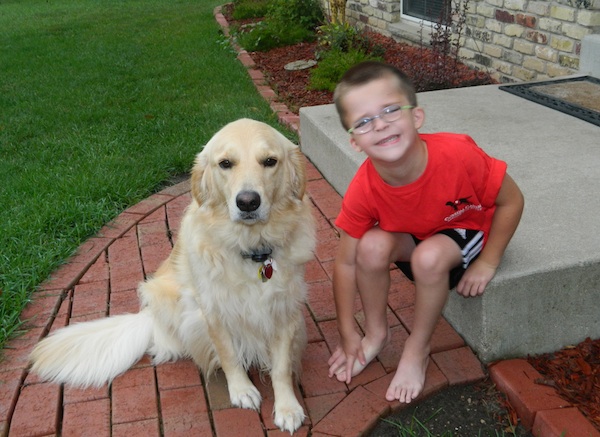
Bennett and his companion dog Journey.
Remember my post about Vision Forward, the conference about educating kids who are blind? I signed more Braille copies of Hanni and Beth: Safe & Sound at that conference than print ones, and this thank-you note from the mom of a five-year-old boy I met there was so moving that I wrote her back to ask if I could share it with my blog readers:
Dear Beth,
I met you at the Vision Forward Conference in Milwaukee this past weekend. I purchased your book, Safe and Sound, for my blind 5 1/2 year old son, Bennett.
My husband read it with him tonight, while I worked on homework with my 9 year old. Bennett was so excited about the book. He told me, “I loved that book you got me. It’s a true story mom. And no one ever writes true stories for kids about people who are blind like me.”
His reaction caused me to think. He is right. If I look on Amazon, there isn’t much out there. Thank you for writing this story and reaching out to children who can not see. Bennett has a Children’s Companion Dog and he said when the story started, he thought for sure it was about his dog Journey.
Thanks again. And it was a pleasure meeting you. Keep writing and we will keep reading 🙂
I swear, any time I’m feeling blue, all I gotta do is read this note. It always makes me smile. A lot of thoughtful people teamed together to make sure Hanni and Beth: Safe & Sound came out in Braille the exact same day it was published in print. That hardly ever, ever happens: Braille is so expensive to publish that “braile presses” usually wait until a book becomes a best-seller before putting it out in Braille.
Hanni and Beth: Safe & Sound is available in a Print-and-Braille format. The Braille and print match line for line, with the print just above the Braille (no pictures). I can tell you first hand, so to speak, that it’s “good Braille” = the dots are stiff, they stand up straight, They’re easy to read. The only problem for me? The Braille version of Hanni and Beth: Safe & Sound was produced in contracted Braille, a form of Braille I’ve never been able to master.
Contracted Braille has a bunch of shorthand symbols (contractions) for commonly used words and parts of words: there’s a cell for the word “and,” another for the word “the,” and so on. Most of the letters of the alphabet are also used as shorthand for common words, such as “c” for “can” and “l” for “like.” Kind of like texting, only you can’t make as many mistakes!
When I wrote Bennett’s mom back to thank her for her note, I apologized that my book was only available in contracted Braille, and poor five-year-old Bennett would have a hard time reading it. No problem, she said. Bennett started learning Braille this past summer. “He knows the whole alphabet, all of the “secret” words for the letters when they are alone, and he just started the words that have 2 Braille letters together, like bc for because,” she said. “Not to brag, but this little guy is a genius!”
I say she should go ahead and brag. Not only about Bennett, but about herself and her husband, too, and the family they are raising, all of them supporting Bennett’s love for reading. A little known fact about Braille: less than 20% of the 50,000 blind children in the United States are proficient in Braille. The American Foundation for the Blind reports a severe shortage of certified teachers of the visually impaired (TVIs), especially in rural areas or in small school districts, and without qualified teachers, it can be a lot easier for parents of children who are blind to just let their kids listen to books on audio or hear words on a talking computer. Technology is cool, but if children who are blind never learn Braille, how will they ever learn to spell correctly? How will they know where to put commas, quotation marks, paragraph breaks and so on?
My children’s book publisher, Blue Marlin Publications, teamed up with Seedlings Braille Books for Children (a non-profit organization in Michigan that creates Braille books for kids who can’t see) to produce my children’s book at a reasonable price — the Braille/print version is actually less expensive than the print version. .Blue Marlin didn’t charge Seedlings a penny for the rights to publish the book in Braille, and wait, there’s more: Blue Marlin Publications also decided to donate a portion of the sales of the print version of Hanni and Beth: Safe & Sound to Seedlings so they can continue creating books in Braille at a reasonable cost for kids who need them.
I do know enough contracted Braille to read the first couple of pages of my children’s book out loud, and with Safe & Sound available in Braille, I’ve been able to read it aloud at school presentations and show kids what Braille looks like and how it works.
I brought a Braille copy along to a visit with the fourth graders at Crow Island School in Winnetka yesterday, but those kids didn’t need any explanation of what Braille is: Jalena, a smart and cheerful 9-year-old in their class, is blind. I invited Jalena to sit with me and help me during the Q & A part of yesterday’s presentation, and she was happy to do so. We answered questions about whether we feel sad not being able to see colors, if we sleep with our eyes open, and how we put our pierced earrings in our ears without looking in a mirror. Not one kid at Crow Island asked about Braille, though: they’re all experts! Lots of Jalena’s sighted friends are in the school’s Braille Club and have learned uncontracted Braille, the version I know.
When the afternoon was over, I thanked Jalena by giving her the Braille copy of Safe & Sound that I’d brought along, and she was delighted. Gail Wilson, her TVI, told me later that after school sometimes Jalena reads with a book buddy who can see. “We have a hard time finding print/Braille books like yours,” she said. “I know for sure what they’ll be reading later today!”
To find out how to order a copy of Hanni and Beth: Safe & Sound in print/Braille, or to donate to Seedlings to help them create more books in Braille for kids, link to www.seedlings.org.
